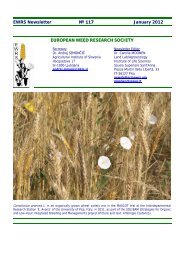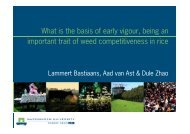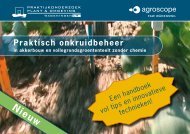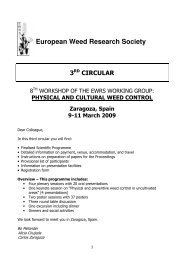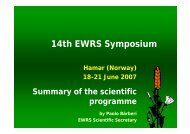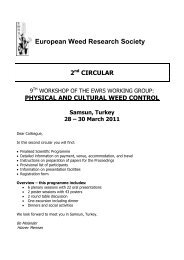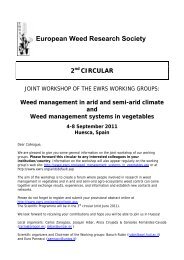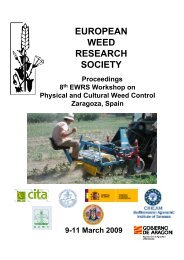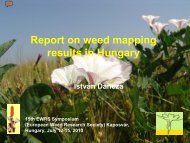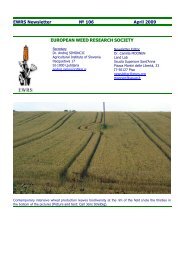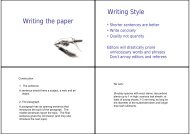Physical and Cultural Weed Control Working Group of - European ...
Physical and Cultural Weed Control Working Group of - European ...
Physical and Cultural Weed Control Working Group of - European ...
Create successful ePaper yourself
Turn your PDF publications into a flip-book with our unique Google optimized e-Paper software.
9 th EWRS Workshop on <strong>Physical</strong> <strong>and</strong> <strong>Cultural</strong> <strong>Weed</strong> <strong>Control</strong> 82<br />
Samsun, Turkey, 28 – 30 March 2011<br />
Effect <strong>of</strong> short duration exposure to high temperatures<br />
on weed seed germination<br />
F. Vidotto 1 , F. De Palo 1 , M. Letey 1 <strong>and</strong> D. Ricauda-Aimonino 2<br />
1) Dipartimento di Agronomia, Selvicoltura e Gestione del Territorio - University <strong>of</strong> Torino<br />
2) Dipartimento di Economia e Ingegneria Agraria Forestale e Ambientale- University <strong>of</strong> Torino<br />
Via Leonardo da Vinci, 44 – 10095 Grugliasco (TO)<br />
<strong>Physical</strong> soil management is considered an alternative to chemical disinfestation to lower the<br />
pressure <strong>of</strong> many soil-borne pests ad diseases, particularly on high-value crops. Thermal methods,<br />
<strong>and</strong> steaming in particular, have proved to be effective also in reducing weed seed germination.<br />
However, limited information exists on requirements in terms <strong>of</strong> temperature <strong>and</strong> time <strong>of</strong> exposure<br />
for seed thermal death in different weed species. Some studies pointed out that in the case <strong>of</strong><br />
steaming, the degrees <strong>of</strong> weed seed devitalisation is strongly related to the maximum temperature<br />
achieved into the soil, while treatment duration seems to play a secondary role.<br />
At this purpose, we started a series <strong>of</strong> experiments aimed at defining, for some weed species,<br />
the effects on germination <strong>of</strong> several combinations <strong>of</strong> temperature <strong>and</strong> time under controlled<br />
conditions. The objective <strong>of</strong> this work, in particular, was to estimate the effect <strong>of</strong> temperature only,<br />
by exposing the seeds for a very short time to a wide range <strong>of</strong> temperatures. Seeds <strong>of</strong> Echinochloa<br />
crus-galli (barnyardgrass), Solanum nigrum (black nightshade), Galinsoga quadriradiata (sin. G.<br />
ciliata, hairy galinsoga), Setaria viridis (green bristlegrass), Portulaca oleracea (little hogweed) <strong>and</strong><br />
Amaranthus retr<strong>of</strong>lexus (redroot amaranth) were treated at twenty thermal levels, ranging from<br />
48°C to 86°C with a 2°C-interval between temperatures. For each species <strong>and</strong> temperature three<br />
10ml Pyrex test-tubes were filled with 3g <strong>of</strong> s<strong>and</strong>y-loam soil mixed with 60 seeds. Soil moisture<br />
was previously adjusted to 80% <strong>of</strong> field capacity. The tubes were maintained at 4°C during the 24h<br />
before the thermal treatment (2h in the case <strong>of</strong> P. oleracea) to prevent seed germination, yet<br />
allowing the seeds to imbibe water from the soil. Thirty minutes before thermal treatment, the tubes<br />
were dipped in a 23°C water bath. Soil temperatures were monitored using T-type thermocouples<br />
inserted into the tubes by-passing the cap <strong>and</strong> in contact with the soil. Temperatures were acquired<br />
by a datalogger every 2s <strong>and</strong> average <strong>of</strong> two probes were used to monitor the temperature into the<br />
tubes. The tubes were dipped in a water bath in which the temperature was set 3°C higher than<br />
treatment temperature, in order to quickly heat the soil. As soon as the temperature in the tubes<br />
reached the treatment temperature, the tubes were immediately immersed in a 1°C water bath until<br />
the attainment <strong>of</strong> the initial temperature <strong>of</strong> 23°C. Immediately after, the seeds <strong>of</strong> each tube were<br />
distributed in three Petri dishes (9cm diameter; 20 seeds/dish), wetted <strong>and</strong> incubated at 25°C for 19<br />
days. For each species three untreated tubes were maintained at room temperature as control.<br />
The thermal resistance to very short exposure <strong>of</strong> each species was described using a<br />
3-parameters log-logistic model, plotting the percentage <strong>of</strong> mortality respect to control (dependent<br />
variable) against the temperature (independent variable). Results showed that the species have a<br />
different thermal susceptibility. Yet, in the majority <strong>of</strong> species seed germination was severely<br />
affected by short exposure to temperatures falling in the range 54-74°C. The only exception was<br />
E. crus-galli, which was much more resistant to heat than other species <strong>and</strong> a temperature higher<br />
than 82°C was required to totally avoid seed germination.



